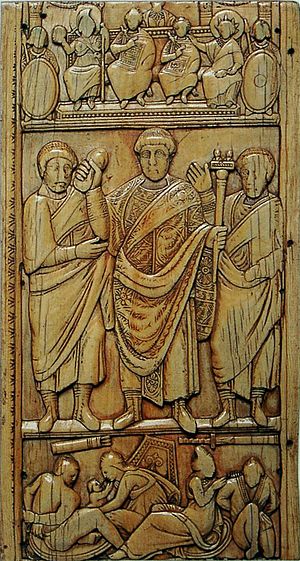Constantius III facts for kids
Quick facts for kids Constantius III |
|
|---|---|

Consular diptych of Constantius III
|
|
| Roman emperor of the West | |
| Reign | 8 February – 2 September 421 (with Honorius) |
| Born | Constantius Unknown date Naissus, Moesia |
| Died | 2 September 421 Ravenna, Italia |
| Spouse | Galla Placidia |
| Issue | |
| Dynasty | Theodosian |
Constantius III was a powerful Roman general who briefly became the Western Roman emperor in 421 AD. He earned his high position because he was a very skilled military leader under Emperor Honorius. Constantius rose to the rank of magister militum, which means 'Master of the Soldiers', by 411 AD.
In that same year, he successfully stopped a major rebellion led by Constantine III, another Roman general who had declared himself emperor. Constantius then led successful military campaigns against different barbarian groups in Hispania (modern-day Spain and Portugal) and Gaul (modern-day France). He managed to win back a lot of land for the Western Roman Empire.
Constantius married Galla Placidia, who was Emperor Honorius's sister, in 417 AD. This marriage showed how important and powerful he had become. Because of his loyalty and success, Honorius made him co-emperor on February 8, 421 AD. Constantius ruled for only seven months before he died on September 2, 421 AD.
Contents
Life of Constantius III
Early Years
Constantius was born in a place called Naissus in Moesia. Today, this area is known as Niš in Serbia. He was from an Illyrian background. Constantius started his career as a general serving under Emperor Honorius. He quickly moved up the ranks, becoming the Magister militum (Master of the Soldiers) by 411 AD. This was a very important military role.
Stopping the Revolt of Constantine III
In 411 AD, Emperor Honorius sent Constantius to deal with a serious problem. A general named Constantine III had declared himself emperor in Britain in 407 AD. Constantius led his army to Arles, which was Constantine's capital city.
When Constantius arrived, he first defeated the army of Gerontius, another general who was also rebelling against Constantine. After that, Constantius began to surround and attack the city of Arles. Constantine refused to give up, hoping that his general Edobichus would return with more soldiers from northern Gaul. Edobichus did come back to Arles, but Constantius quickly defeated his forces.
Soon after, Constantine lost even more of his army. His soldiers who were guarding the Rhine River decided to support a different rebel leader named Jovinus. This forced Constantine to surrender. Constantius had him imprisoned, and Constantine died shortly after. Even with this victory, the Romans were never able to fully control Britain again.
Military Campaigns
In 416 AD, Constantius started a major military campaign against the Visigoths in northern Hispania. He used a strategy called a blockade, cutting off their supplies to make them surrender due to hunger. Soon, the Visigoth king, Wallia, gave up and agreed to work with Rome.
As part of the agreement, Wallia returned Galla Placidia to the Romans. Galla Placidia was Emperor Honorius's sister, and she had been captured by Alaric around 412 AD. Wallia also agreed to fight against the Vandals and other barbarian groups that were still causing trouble for the Romans. In return, Constantius provided the Visigoths with food. Constantius continued to lead campaigns against various tribes, and by 420 AD, he had regained control of much of Hispania and Gaul for the Western Roman Empire.
Becoming Emperor
During this time, skilled generals were extremely important for Roman emperors to stay in power, especially in the Western Roman Empire. Constantius's position as magister militum and his great military skills gave him a lot of power and influence. He was as influential as earlier powerful generals like Stilicho.
Because of his importance, Emperor Honorius gave Constantius many honors. He was appointed consul three times: in 414 AD, in 417 AD (alongside Honorius himself), and in 420 AD (alongside Theodosius II). To make sure Constantius remained loyal, Honorius arranged for his sister, Galla Placidia, to marry Constantius in 417 AD.
Finally, on February 8, 421 AD, Honorius made Constantius a co-emperor of the Western Roman Empire. Constantius ruled as co-emperor for only seven months before he died on September 2, 421 AD, in Ravenna. Honorius then ruled alone until his own death in 423 AD. After Honorius died, Constantius's son, Valentinian III, became the new emperor, with Galla Placidia serving as his regent (someone who rules for a young emperor).
See also
 In Spanish: Constancio III para niños
In Spanish: Constancio III para niños

